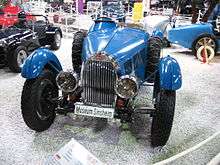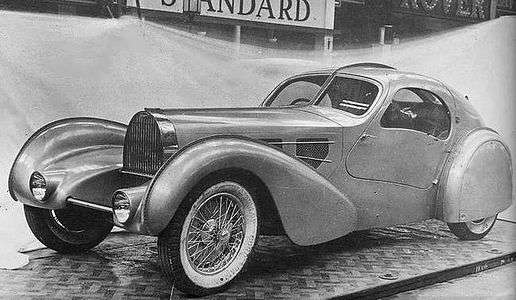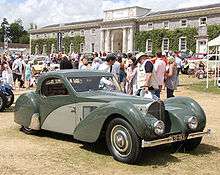Bugatti Type 57
| Bugatti Type 57 | |
|---|---|
 | |
| Overview | |
| Manufacturer | Bugatti |
| Production |
1934–1940 710 produced |
| Body and chassis | |
| Class | Grand tourer (GT) |
| Powertrain | |
| Engine | 3,257 cc DOHC Inline 8 |
| Chronology | |
| Predecessor | Bugatti Type 49 |
| Successor | Bugatti Type 101 |
The Bugatti Type 57[1] and later variants (including the famous Atlantic and Atalante) was an entirely new design created by Jean Bugatti, son of founder Ettore.[2] Type 57s were built from 1934 through 1940, with a total of 710 examples produced.
Type 57s used a twin-cam 3,257cc engine based on that of the Type 49 but heavily modified by Jean Bugatti, unlike the single cam engines of the Type 49 and earlier models.[3] The engines of the Type 50, 51 used bevel gears at the front of the engine to transmit power from the crankshaft, whereas the Type 57 used a train of spur gears at the rear of the engine, with fiber gear wheels on the camshafts to achieve more silence in operation.
There were two basic variants of the Type 57 car:
The Type 57 chassis and engine was revived in 1951 as the Bugatti Type 101.
A rediscovered Type 57 sold for 3.4 million euros at auction on 7 February 2009 at a motor show in Paris.[4]
Type 57

The original Type 57 was a touring car model produced from 1934 through 1940. It used the 3.3 L (3,257 cc; 198 cu in) engine from the Type 59 Grand Prix cars, producing 135 hp (100 kW). Top speed was 153 kilometres per hour (95 mph).
It rode on a 3,302 mm (130 in) wheelbase and had a 1,349 mm (53 in) wide track. Road-going versions weighed about 950 kg (2,090 lb). Hydraulic brakes replaced the cable-operated units in 1938, a modification Ettore Bugatti hotly contested. 630 examples were produced.
The original road-going Type 57 included a smaller version of the Royale's square-bottom horseshoe grille. The sides of the engine compartment were covered with thermostatically-controlled shutters. It was a tall car, contrary to the tastes of the time.
Dimensions:
- Wheelbase: 3,302 mm (130 in)
- Track: 1,349 mm (53 in)
- Weight: 950 kg (2,090 lb)
Type 57T

The "tuned" Type 57T pushed the performance of the basic Type 57. It was capable of reaching 185 kilometres per hour (115 mph).
Type 57C

A Type 57C racing car was built from 1937 through 1940, with about 96 produced. It shared the 3.3 L engine from the road-going Type 57 but produced 160 hp (119 kW) with a Roots-type supercharger fitted.
Type 57C Tank
The 2nd incarnation Tank, this time based on the Type 57C, won Le Mans again in 1939. Shortly afterwards, Jean Bugatti took the winning car for a test on the Molsheim-Strasbourg road. Swerving to avoid a drunken bicyclist on the closed road, Bugatti crashed the car and died at age 30.
Type 57S/SC

The Type 57S/SC variants are some of the most iconic Bugatti cars. The "S" stood for "Surbaissé" ("Lowered") and the "C" for "Compresseur" (a supercharger introduced by Bugatti as a result of customer's desire for increased power). It included a V-shaped dip at the bottom of the radiator and mesh grilles on either side of the engine compartment.
Lowering the car was a major undertaking. The rear axle now passed through the rear frame rather than riding under it, and a dry-sump lubrication system was required to fit the engine under the new low hood. The 57S had a nearly-independent suspension in front, though Ettore despised that notion.
Just 43 "Surbaissé" cars[5] and only two supercharged Type 57SC's were originally manufactured. But most 57S owners wanted the additional power afforded by the blower. Therefore, most of the original Type 57S cars returned to Molsheim for the installation of a supercharger, pushing output from 175 hp (130 kW) to 200 hp (150 kW) and 190 km/h (120 mph). 2014 saw the unveiling of Ralph Lauren's unique $40 million version of this classic.
Dimensions:
- Wheelbase: 2,979 mm (117 in)
- Track: 1,349 mm (53 in)
- Weight: 950 kg (2,090 lb)
"Aérolithe" concept and Atlantic production cars


The Atlantic body Type 57S featured flowing coupe lines with a pronounced dorsal seam running front to back. It was based on the 1935 Aérolithe concept car designed by Jean Bugatti. Like the Type 59 Grand Prix car, the Aérolithe used Elektron (a magnesium alloy) or Duralumin (an aluminium alloy) for its body panels. Therefore, the body panels were riveted externally, creating the signature seam.
However the production Atlantics (just four were made) used plain aluminium, but the dorsal seams were retained for style, and have led to the car's present fame. Also, the first and the second of the Atlantics were described as "Aéro Coupes", both based on the same mechanics as the Aérolithe concept.
Three of the original four cars are known to survive and each has been restored to their former glory. Two have been honored with Best of Show awards at the Pebble Beach Concours d'Elegance.
| Year of production | Chassis Number | Specifications | Short description |
|---|---|---|---|
| 1936 | 57374 | Bugatti Type 57SC - Aéro Coupe | The first of the four Atlantic cars built by Bugatti. It was completed on September 1936 and sold to Victor Rothschild, 3rd Baron Rothschild.[6] The vehicle was restored over long term ownership of Dr. Peter Williamson in New Hampshire. The restoration culminated in Best of Show at the 2003 Pebble Beach Concours, shortly before Dr. Williamson's passing. 57374 was then sold (at a reported price over $30 million) to Peter Mullin of the Mullin Automotive Museum near Los Angeles. Lately, the vehicle had been transferred to the Petersen Automotive Museum where it is currently being displayed. |
| 1936 | 57453 | Bugatti Type 57S - Aéro Coupe | Also known as "La voiture noire" ("The black car"), this is the second Atlantic that was manufactured. Apart from its first years after production, the car's history is unknown. It was built by Bugatti and finished in October, 1936, later to be used for the company's brochures and exhibited to 1937 Nice and Lyon Motor Shows. Lately, it was driven by Jean Bugatti and then by Mr. William Grover-Williams and his wife. Formerly, the Grover-Williams spouses moved to England shortly after the World War II broke out and the car was lost. The last mention about this vehicle was on a list of cars that were sent to Bordeaux in February, 1941. |
| 1936 | 57473 | Bugatti Type 57S - Atlantic Coupe | Succeeding chassis 57453, this vehicle was finished in December 1936 and it was delivered to its first owner, Mr. Jacques Holzschuch. He eventually died by the end of the World War II and the car was sold to the renowned Paris coachbuilder Joseph Figoni. The vehicle received significant styling changes in the hands of its current owner, so 57473 stands different than the other Atlantics. Its history takes a dark turn afterwards. After World War II it spent some time as a racecar and then was sold to Rene Chatard. He and a female companion were driving the car near Gien, France when they were hit by a train. Neither survived the crash and the car was confiscated by the French police. Most of the car survived but what remained was purchased in 1965 by an enthusastic Frenchman who began a full reconstruction. The car was finished in 1977 and then went on to several owners before the car underwent a full restoration by Paul Russell and Co. in 2006. The car has been restored to its Figoni specification and won acclaim at the 2010 Pebble Beach Concours d'Elegance. |
| 1937 | 57591 | Bugatti Type 57SC - Atlantic Coupe | This final production Atlantic led a charmed life that continues to this day. It was originally sold to a Bugatti enthusiast in Great Britain. It came under the ownership of Ralph Lauren, who then commissioned a full restoration with Paul Russell and Co. 57591 was unrestored at the time but had received multiple rebuilds and touch-ups through the years. Russell and Co. were able to cut through the past restoration work and revive the car back to its 1937 glory. They were rewarded with Best of Show at Pebble Beach in 1990 and Best of Show at Villa d'Este in 2013, along with many other top awards. |
Type 57S45
A special Type 57 S45 used a 4,743 cc engine like the Tank.
Type 57G Tank
The famous, 57S-based, 57G Tank won the 1936 French Grand Prix, as well as the 1937 24 Hours of Le Mans. Three 57G Tanks were produced. Chassis number 57335, the Le Mans winner is the only one known to exist and is currently on display at the Simeone Foundation Automotive Museum in Philadelphia.[7]
Atalante

The Atalante was a two-door coupe body style similar to and built after the Atlantic, built on both the Type 57 and 57S, but with a single piece windscreen and no fin. Only 17 Atalante cars were made, four of which reside in the Cité de l'Automobile Museum in Mulhouse, France (formerly known as the Musee Nationale de L'Automobile de Mulhouse).
One Atalante, chassis number 57 784, with a 3 seats, 37 cm elongated aluminium bodywork made by Vanvooren, resides in the Museu do Caramulo in Caramulo, Portugal. Vanvooren would do two more bodies alike, one (Chassis 57808) for the French government, who gave it, in 1939, as a marriage gift of Prince Reza and Princess Fawzia, and another one (Chassis 57749). These two cars are in private collections in the United States.[8]
The name Atalante was derived from a heroine of Greek mythology, Atalanta.
Rediscovered Type 57S Atalante
In 2008 the Bugatti Type 57S with chassis number 57502 built in 1937 with the Atalante coachwork for Francis Curzon, 5th Earl Howe was discovered in a private garage in Newcastle upon Tyne, having been stored untouched for 48 years and known about only by a select few people.[9] It was auctioned in February 2009 at the Rétromobile motor show in Paris, France, fetching €3.4 million (~ US$5 million), becoming one of the highest valued cars in automotive history, owing much to its extremely low mileage, original condition and ownership pedigree.
References
- Ray Bonds (2003). The Illustrated Directory of Sports Cars. Motorbooks. ISBN 0-7603-1420-9.
- ↑ Barrie Price. Bugatti 57: The Last French Bugatti. ISBN 9781901295665.
- ↑ Charles Lam Markmann, Mark Sherwin. The Book of Sports Cars - (France and Germany). ISBN 9788896365458.
- ↑ Jarraud, Robert: Bugatti Doubles Arbres, Editions de l'Automobiliste, 1977,page 44
- ↑ "Classic Bugatti makes 3.4m euros". BBC News online. 4 November 2008. Retrieved 10 July 2009.
- ↑ 1937 Bugatti Type 57S. www.conceptcarz.com. n.d. Retrieved 1 January 2009.
The Type 57S was a short-wheelbase sport version of Bugatti's twin-camshaft, straight eight, 3.3 liter Type 57 model, and featured a 'V' radiator. Only 43 examples were built between 1936 and 1938, and this one was the last of 17 to be fitted with factory built black Atalante coupe coachwork...The Type 57S has been called the ultimate road going Bugatti. It is also one of the rarest...The Type 57 and its variants were intended for road going use...The catalogue bodies included two versions of the Ventoux Coupe, the Galibier four-door sedan, the Stelvio cabriolet, Atalante and Atlantic. The Atlantic, and its derivative the Atalante, were constructed in two-door coupe configuration.
External link in|publisher=(help) - ↑ "The Bugatti Revue".
- ↑ Simeone, Frederick A. (2009). The Spirit of Competition. Philadelphia, PA USA: Coachbuilt Press. p. 229. ISBN 9780977980949.
- ↑ "Bugatti 57C Atalante". Museu do caramulo. n.d. Retrieved 31 July 2015.
- ↑ "1937 Type 57S Atalante found in Tyneside garage". BBC Online. 1 January 2009.
External links
| Wikimedia Commons has media related to Bugatti Type 57. |
| Automobiles Ettore Bugatti, car timeline, 1910–1962 next » | ||||||||||||||||||||||||||||||||||||||||||||||||||||||
|---|---|---|---|---|---|---|---|---|---|---|---|---|---|---|---|---|---|---|---|---|---|---|---|---|---|---|---|---|---|---|---|---|---|---|---|---|---|---|---|---|---|---|---|---|---|---|---|---|---|---|---|---|---|---|
| Type | 1910s | 1920s | 1930s | 1940s | 1950s | 1960s | 1963–86 | |||||||||||||||||||||||||||||||||||||||||||||||
| 0 | 1 | 2 | 3 | 4 | 5 | 6 | 7 | 8 | 9 | 0 | 1 | 2 | 3 | 4 | 5 | 6 | 7 | 8 | 9 | 0 | 1 | 2 | 3 | 4 | 5 | 6 | 7 | 8 | 9 | 0 | 1 | 2 | 3 | 4 | 5 | 6 | 7 | 8 | 9 | 0 | 1 | 2 | 3 | 4 | 5 | 6 | 7 | 8 | 9 | 0 | 1 | 2 | ||
| Owner | Defunct | |||||||||||||||||||||||||||||||||||||||||||||||||||||
| Company name |
Defunct | |||||||||||||||||||||||||||||||||||||||||||||||||||||
| Touring car |
Type 30 / Type 49 | Type 57 | ||||||||||||||||||||||||||||||||||||||||||||||||||||
| Type 46 | ||||||||||||||||||||||||||||||||||||||||||||||||||||||
| Limousine | Type 41 Royale | |||||||||||||||||||||||||||||||||||||||||||||||||||||
| Roadster | Type 13 / Brescia Tourer | Type 55 | ||||||||||||||||||||||||||||||||||||||||||||||||||||
| Coupé | Type 101 | |||||||||||||||||||||||||||||||||||||||||||||||||||||
| Sports car |
Type 13 | Type 18 | Type 252 | |||||||||||||||||||||||||||||||||||||||||||||||||||
| Race car | Type 32 |
Type 35 | ||||||||||||||||||||||||||||||||||||||||||||||||||||